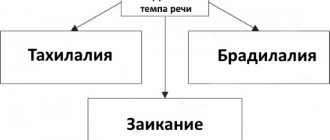Dysphasia is a persistent underdevelopment or complete absence of speech caused by organic lesions of the cortical areas of the brain responsible for speech development. Unlike aphasia, in which there is a loss of already formed speech (due to injury, vascular diseases of the brain, tumors, brain surgery, etc.), dysphasia begins to develop in the prenatal period or at the early pre-speech stage of the child’s development. The severity of the disease depends on the time at which the brain damage occurred; the most dangerous period is 3-4 months of pregnancy. In the Russian classification of diseases, this disease is called alalia (not to be confused with dyslalia - a distortion of speech, sound pronunciation, which is not considered a gross violation of speech development up to 5 years), and in various sources you can find the names: “developmental dysphasia” or “early childhood aphasia.”
Causes of dysphasia
Dysphasia can be caused by one or more reasons:
- intoxication of the fetus during pregnancy due to maternal use of alcohol, nicotine, drugs or large doses of medications, also due to poisoning with chemicals and household toxins;
- diseases and infections suffered during pregnancy (syphilis, toxoplasmosis, cytomegalovirus, rubella, etc.);
- inadequate and meager nutrition of a pregnant woman (for example, acute lack of protein);
- iodine deficiency in the mother during pregnancy;
- Rh conflict, immunological incompatibility of blood between mother and child;
- birth injury to the newborn's brain;
- traumatic brain injuries in a child in the pre-speech period;
- fetal asphyxia during the prenatal period or at birth;
- genetic, hereditary predisposition;
- neuroinfections.
Symptoms of dysphasia
Most symptoms of dysphasia are nonspecific and characteristic of many diagnoses associated with speech dysfunctions. Each specific case must be assessed in conjunction with clarification of the structure of the defect and the presence of several symptoms at once:
- late appearance of babbling and absence of onomatopoeia in the first and second years of life (“meow”, “bang”, “am”, “woof”);
- poor vocabulary after 2.5 years;
- absence of generalizing words, synonyms, antonyms in speech after 3 years;
- excessive silence (the child seems to understand everything, but simply does not want to speak);
- problems with full pronunciation of words and sentences in children over 5 years old (the child distorts words, pronounces only the first syllable);
- partial or complete misunderstanding of the speech of other people in children over 2 years old, lack of interest in it (the child may react incorrectly to some requests, not respond to his own name, during a conversation he carefully looks at the interlocutor’s mouth, as if trying to read on the lips)
- a child with dysphasia often uses facial expressions and gestures to communicate, replacing words with them;
- Dysphatic children are characterized by speech disorders such as echolalia (constant repetition of new, just heard words, which occurs automatically and cannot be controlled) and logorrhea (speech pathology, manifested in excessive verbosity, speech agitation).
Speech development delays in children: causes, diagnosis and treatment
For citation.
Zavadenko N.N., Suvorinova N.Yu. Speech development delays in children: causes, diagnosis and treatment // RMJ. 2021. No. 6. pp. 362–366. Speech development delays usually mean a lag in speech formation from age standards in children under the age of 3–4 years.
Meanwhile, this formulation implies a wide range of speech development disorders that have different causes. The period from the first year of life to 3–5 years is decisive for the formation of speech. At this time, the brain and its functions intensively develop. Any disturbances in speech development are a reason for immediate contact with specialists - a doctor (pediatrician, child neurologist, ENT doctor, child psychiatrist), speech therapist, psychologist. This is all the more important because it is in the first years of life that deviations in the development of brain functions, including speech, are best amenable to correction. Speech and its functions.
Speech is a special and most perfect form of communication, inherent only to humans.
In the process of verbal communication (communication), people exchange thoughts and interact with each other. Speech is an important means of communication between a child and the world around him. The communicative function of speech contributes to the development of communication skills with peers, develops the ability to play together, which is invaluable for the formation of adequate behavior, the emotional-volitional sphere and personality of the child. The cognitive function of speech is closely related to the communicative function. The regulatory function of speech is formed already in the early stages of child development. However, the adult’s word becomes a true regulator of the child’s activity and behavior only by the age of 4–5, when the child’s semantic side of speech is already significantly developed. The formation of the regulatory function of speech is closely related to the development of internal speech, purposeful behavior, and the ability for programmed intellectual activity. Speech development disorders affect the overall development of children’s personality, their intellectual growth and behavior, and make it difficult to learn and communicate with others [1, 2]. Forms of speech development disorders.
Specific language development disorders include those disorders in which normal language development is affected in the early stages.
According to the ICD-10 classification [3], these include disorders of the development of expressive language (F80.1) and receptive language (F80.2). In this case, disturbances appear without a previous period of normal speech development. Specific speech development disorders are the most widespread disorders of neuropsychic development; their frequency of occurrence in the child population is 5–10% [1, 4]. Alalia
(according to modern international classifications - “dysphasia” or “developmental dysphasia”) is a systemic underdevelopment of speech, it is based on an insufficient level of development of the speech centers of the cerebral cortex, which can be congenital or acquired in the early stages of ontogenesis, in the pre-speech period .
In this case, first of all, children’s ability to speak suffers; expressive speech is characterized by significant deviations, while speech understanding can vary, but, by definition, is much better developed [2]. The most common variants (expressive and mixed expressive-receptive disorders) are manifested by a significant delay in the development of expressive speech compared to the development of understanding. Due to difficulties in organizing speech movements and their coordination, independent speech does not develop for a long time or remains at the level of individual sounds and words. Speech is slow, poor, vocabulary is limited. There are many slips of the tongue (paraphasias), permutations, and perseverations in speech. Growing up, children understand these mistakes and try to correct them. In modern literature, both terms are used - “specific speech development disorders” and “developmental dysphasia” - and they refer to the same group of pediatric patients. But “developmental dysphasia” is considered a more accurate formulation of the diagnosis, since this term reflects both the neurological and evolutionary-age aspects of this disorder [2, 5]. Complete or partial loss of speech caused by local lesions of the speech areas of the cerebral cortex is called aphasia. Aphasia is the decay of already formed speech functions, so this diagnosis is made only after 3–4 years. With aphasia, there is a complete or partial loss of the ability to speak or understand someone else's speech. Dysarthria
is a violation of the sound pronunciation side of speech as a result of a violation of the innervation of the speech muscles.
Depending on the location of the lesion in the central nervous system (CNS), several variants of dysarthria are distinguished: pseudobulbar, bulbar, subcortical, cerebellar. Depending on the leading disorders underlying speech disorders in children, L.O. Badalyan [6] proposed the following clinical classification. I. Speech disorders associated with organic damage to the central nervous system. Depending on the level of damage, they are divided into the following forms: 1. Aphasia - the collapse of all components of speech as a result of damage to the cortical speech areas. 2. Alalia is a systemic underdevelopment of speech as a result of damage to the cortical speech zones in the pre-speech period. 3. Dysarthria - a violation of the sound pronunciation side of speech as a result of a violation of the innervation of the speech muscles. Depending on the location of the lesion, several variants of dysarthria are distinguished. II. Speech disorders associated with functional changes in the central nervous system (stuttering, mutism and surdomutism). III. Speech disorders associated with defects in the structure of the articulatory apparatus (mechanical dyslalia, rhinolalia). IV. Delayed speech development of various origins (due to prematurity, severe diseases of internal organs, pedagogical neglect, etc.). In the domestic psychological and pedagogical classification
[7], alalia (dysphasia), along with other clinical forms of speech retardation in children, is considered from the standpoint of general speech underdevelopment (GSD).
This classification is based on the principle “from particular to general”. OHP is heterogeneous in its developmental mechanisms and can be observed in various forms of oral speech disorders (alalia, dysarthria, etc.). Common signs include a late onset of speech development, a poor vocabulary, agrammatisms, pronunciation defects, and phoneme formation defects [7]. Underdevelopment can be expressed to varying degrees: from the absence of speech or its babbling state to extensive speech, but with elements of phonetic and lexico-grammatical underdevelopment. The three levels of OHP differ as follows: 1st – absence of common speech (“speechless children”), 2nd – the beginnings of common speech and 3rd – extensive speech with elements of underdevelopment in the entire speech system. The development of ideas about OSD is focused on creating correction methods for groups of children with similar manifestations of various forms of speech disorders. The concept of ONR reflects the close relationship of all components of speech during its abnormal development, but at the same time emphasizes the possibility of overcoming this lag and moving to qualitatively higher levels of speech development. However, the primary mechanisms of ANR cannot be elucidated without a neurological examination, one of the important tasks of which is to determine the location of the lesion in the nervous system, i.e., making a topical diagnosis. At the same time, diagnostics is aimed at identifying the main disrupted links in the development and implementation of speech processes, on the basis of which the form of speech disorders is determined. There is no doubt that when using the clinical classification of speech development disorders in children, a significant part of cases of OSD are associated with developmental dysphasia (alalia). For the normal development of speech
, it is necessary that the brain and especially the cortex of its cerebral hemispheres reach a certain maturity, the articulatory apparatus is formed, and hearing is preserved.
Another indispensable condition is a complete speech environment from the first days of a child’s life. The reasons for the delay in speech development
may be pathology during pregnancy and childbirth, dysfunction of the articulatory apparatus, damage to the organ of hearing, a general lag in the mental development of the child, the influence of heredity and unfavorable social factors (insufficient communication and education).
Difficulties in mastering speech are also typical for children with signs of retarded physical development, those who suffered serious illnesses at an early age, those who are weakened, or those who receive malnutrition. Hearing impairment
is the most common cause of isolated speech delay [8].
It is known that even moderately pronounced and gradually developing hearing loss can lead to delays in speech development. Signs of hearing loss in a baby include a lack of response to sound signals and an inability to imitate sounds, while in an older child there is excessive use of gestures and close observation of the movements of the lips of speaking people. However, the assessment of hearing based on the study of behavioral reactions is insufficient and is subjective. Therefore, if partial or complete hearing loss is suspected in a child with isolated speech delay, it is necessary to conduct an audiological examination. The method of recording auditory evoked potentials also provides reliable results. The sooner hearing defects are detected, the sooner it will be possible to begin appropriate corrective work with the baby or equip him with a hearing aid. The causes of delayed speech development in a child may be autism
or
general mental retardation
, which is characterized by uniform incomplete formation of all higher mental functions and intellectual abilities.
To clarify the diagnosis, an in-depth examination is carried out by a pediatric psychoneurologist [9]. On the other hand, it is necessary to distinguish between tempo delays in speech development
caused by a lack of stimulation of speech development under the influence of unfavorable social factors (insufficient communication and education).
A child’s speech is not an innate ability; it is formed under the influence of the speech of adults and largely depends on sufficient speech practice, a normal speech environment, and on upbringing and training, which begin from the first days of a child’s life. The social environment stimulates speech development and provides a speech pattern. It is known that in families with poor speech impulses, children begin to speak late and speak little. A delay in speech development may be accompanied by a general lack of development, while the natural intellectual and speech abilities of these children correspond to the norm. Neurobiological factors in the pathogenesis of speech development disorders.
Perinatal pathology of the central nervous system plays a significant role in the formation of speech disorders in children.
This is due to the fact that it is in the perinatal period that the most important events occur that have a direct and indirect impact on the processes of the structural and functional organization of the central nervous system. Taking this into account, it is advisable to identify risk groups for disorders of psycho-speech development already in the 1st year of life [10]. The high-risk group should include children who, in the first 3 months. life as a result of the examination, structural changes in the central nervous system were revealed, premature infants (especially with extremely low body weight), children with analyzer disorders (auditory and visual), insufficiency of cranial nerve functions (in particular V, VII, IX, X, XII), children with a delay in the reduction of unconditioned automatisms, long-lasting disorders of muscle tone [10]. In premature newborns, especially those with a short gestation period, an important period of development of the central nervous system (interneuronal organization and intensive myelination) occurs not in utero, but under difficult conditions of postnatal adaptation. The duration of this period can vary from 2–3 weeks. up to 2–3 months, and this period is often accompanied by the development of various infectious and somatic complications, which serves as an additional factor causing disturbances in psychomotor and speech development in immature and premature children. One of the main consequences of prematurity—hearing impairment—plays a negative role [10]. Studies have shown that approximately half of very premature children have delayed speech development, and at school age they have learning difficulties, problems with reading and writing, concentration and behavior control [11]. In recent years, the role of genetic factors in the formation of speech development disorders has also been confirmed [10]. Development of speech skills is normal.
For timely and accurate diagnosis of speech disorders in children, it is necessary to take into account the patterns of normal speech development. Children pronounce their first words by the end of the first year of life, but they begin to train their speech apparatus much earlier, from the first months of life, so the age of up to one year is a preparatory period in the development of speech. The sequence in the development of pre-speech reactions is shown in Table 1.
So, in the first year of life, the child’s speech apparatus is preparing to pronounce sounds. Humming, “flute”, babbling, modulated babbling are a kind of game for the baby and give the child pleasure; for many minutes he can repeat the same sound, training in a similar way in the articulation of speech sounds. At the same time, the active formation of speech understanding occurs. An important indicator of speech development up to one and a half to two years is not so much the pronunciation itself, but the understanding of addressed speech (receptive speech). The child must listen carefully and with interest to adults, understand speech addressed to him well, recognize the names of many objects and pictures, and follow simple everyday requests and instructions. In the second year of life, words and sound combinations already become a means of verbal communication, that is, expressive speech is formed. The main indicators of normal speech development from 1 year to 4 years: • The appearance of clear, meaningful speech (words) – 9–18 months. • At first (up to one and a half years), the child mainly learns to understand speech, and from 1.5–2 years he quickly develops active speech and his vocabulary grows. The number of words that the baby understands (passive vocabulary) is still greater than the number of words that he can pronounce (active vocabulary). • The appearance of phrases of 2 words – 1.5–2 years, of 3 words – 2–2.5 years, of 4 or more words – 3–4 years. • Volume of active vocabulary: – by 1.5 years, children pronounce 5–20 words, – by 2 years – up to 150–300 words, – by 3 years – up to 800–1000 words, – by 4 years – up to 2000 words Early signs of trouble in speech formation.
Children who do not try to speak at 2–2.5 years should be a cause for concern. However, parents may notice certain prerequisites for problems in speech development earlier. In the first year of life, one should be alarmed by the absence or weak expression at appropriate times of humming, babbling, first words, reaction to adult speech and interest in it; at one year - the child does not understand frequently used words and does not imitate speech sounds, does not respond to speech addressed to him, and resorts only to crying to attract attention to himself; in the second year - lack of interest in speech activity, replenishment of passive and active vocabulary, the appearance of phrases, inability to understand the simplest questions and show an image in a picture. At 3–4 years of life, signs of dysfunctional speech formation should cause high concern in comparison with the normal characteristics of its development, which are given in Table 2. Lack of assistance at an early age for children with speech underdevelopment leads to a number of consequences: communication disorders and conditioned They include difficulties in adapting to a group of children and in contacts with other people, immaturity in the emotional sphere and behavior, and insufficient cognitive activity. This is confirmed by the data of our study to assess the indicators of age-related development of children with dysphasia [12]. We examined 120 patients aged from 3 to 4.5 years (89 boys and 31 girls) with developmental dysphasia - a disorder of expressive speech development (F80.1 according to ICD-10 [3]) and a picture of level 1-2 OHP according to psychological and pedagogical classification [7]. Children whose speech development delay was caused by hearing loss, mental retardation, autism, severe somatic pathology, malnutrition, as well as the influence of unfavorable social factors (insufficient communication and education) were excluded from the study group. We studied indicators of age-related development using the Developmental Profile 3 (DP-3) methodology [13] in five areas: motor skills, adaptive behavior, social-emotional sphere, cognitive sphere, speech and communication abilities. A structured interview form was used, conducted by a specialist with parents. Based on the data obtained, it was determined what age the child’s development corresponds to in each of the areas and at what age interval he lags behind the normal indicators for his calendar age. When studying the anamnesis, many parents indicated that already at an early age they paid attention to the absence or limitation of babbling in children. Parents noted silence and emphasized that the child understood everything, but did not want to speak. Instead of speech, facial expressions and gestures developed, which children used selectively in emotionally charged situations. The first words and phrases appeared late. Parents noted that, apart from speech delays, in general the children were developing normally. The children had a poor active vocabulary and used babbling words, onomatopoeia, and sound complexes. There were many reservations in the speech, which the children paid attention to and tried to correct what was said incorrectly. At the time of the examination, the volume of the active vocabulary (stock of spoken words) in children with level 1 SLD did not exceed 15–20 words, and with level 2 SLD – 20–50 words. Table 3 presents the results of the examination, showing at what age interval there was a lag from normal indicators in three groups of children with developmental dysphasia, divided by age: (1) from 3 years 0 months. up to 3 years 5 months; (2) from 3 years 6 months. up to 3 years 11 months; (3) from 4 years 0 months. up to 4 years 5 months
It seems logical that the most significant lag was in the formation of speech and communication abilities, but at the same time the degree of this lag increased - from 17.3 ± 0.4 months. in the 1st group to 21.2±0.8 in the 2nd and 27.3±0.5 months. in the 3rd group. Along with the increase in the severity of differences from healthy peers in speech development, the lag in all other areas not only persisted, but also increased with each six-month age period. This indicates, on the one hand, the significant influence of speech on other areas of the child’s development, and on the other, the close relationship and inextricability of various aspects of individual development. The main directions of complex therapy
for developmental dysphasia in children are: speech therapy work, psychological and pedagogical correctional measures, psychotherapeutic assistance to the child and his family, drug treatment.
Since developmental dysphasia is a complex medical, psychological and pedagogical problem, the complexity of the impact and continuity of work with children by specialists of various profiles are of particular importance when organizing assistance to such children. Speech therapy assistance is based on the ontogenetic principle, taking into account the patterns and sequence of speech formation in children. In addition, it is individual, differentiated, depending on a number of factors: the leading mechanisms and symptoms of speech disorders, the structure of the speech defect, the age and individual characteristics of the child. Speech therapy and psychological-pedagogical correctional activities are a purposeful, complexly organized process that is carried out over a long period of time and systematically. Under these conditions, correctional work gives most children with developmental dysphasia the means sufficient for verbal communication. The most complete correction of speech development disorders is facilitated by the timely use of nootropic drugs. Their prescription is justified based on the main effects of this group of drugs: nootropic, stimulating, neurotrophic, neurometabolic, neuroprotective. One of these drugs is acetylaminosuccinic acid (Cogitum). Cogitum is an adaptogenic and general tonic that normalizes nervous regulation processes and has immunostimulating activity. Cogitum contains acetylaminosuccinic acid (in the form of dipotassium salt of acetylaminosuccinate) - a synthetic analogue of aspartic acid - a non-essential amino acid found mainly in the tissues of the central nervous system. For pediatricians and pediatric neurologists, such properties of aspartic acid are important, such as participation in DNA and RNA synthesis, influence on increasing physical activity and endurance, normalization of the balance between the processes of excitation and inhibition in the central nervous system, immunomodulatory effect (acceleration of antibody formation processes) [14]. Aspartic acid is involved in a number of metabolic processes, in particular, it regulates carbohydrate metabolism by stimulating the transformation of carbohydrates into glucose and the subsequent creation of glycogen reserves; Along with glycine and glutamic acid, aspartic acid serves as a neurotransmitter in the central nervous system, stabilizes nervous regulation processes and has psychostimulating activity [14]. In neuropediatric practice, the drug has been used for many years for indications such as delayed psychomotor and speech development, consequences of perinatal lesions of the central nervous system, neuroinfections and traumatic brain injuries, cerebrasthenic and astheno-neurotic syndromes. Release form. Oral solution in ampoules of 10 ml. 1 ml of the drug contains 25 mg of acetyl-aminosuccinic (aspartic) acid, and 1 ampoule (10 ml) – 250 mg. The composition of the drug includes: fructose (levulose) - 1.0 g, methyl parahydroxybenzoate (methyl-n-hydroxybenzoate) - 0.015 g, aromatics (banana flavor) - 0.007 g, distilled water - up to 10 ml per 1 ampoule. The drug does not contain crystalline sugar or its synthetic substitutes, therefore it is not contraindicated in diabetes mellitus. Dosage regimens. The drug is given orally undiluted or with a small amount of liquid. For children aged 7–10 years, it is recommended to take 1 ampoule (250 mg) orally in the morning, for children over 10 years old – 1–2 ampoules (250–500 mg) in the morning. For patients from 1 to 7 years of age, the dose is determined by the doctor individually [14]. In our experience, it is preferable for children under 7 years of age to take 5 ml (1/2 ampoule) 1 or 2 times a day. The duration of treatment is usually 2–4 weeks. For a single dose, the drug is prescribed in the morning, for a double dose, the second dose is prescribed no later than 16–17 hours. Before prescribing Cogitum, it is necessary to obtain written informed consent from parents/legal representatives for treating a child with acetylaminosuccinic acid, indicating that they are familiar with the indications, contraindications and side effects and do not object to prescribing the drug to a child. Side effects.
Although hypersensitivity reactions (allergic reactions) to individual components of the drug are possible, they are rare. There are no reports of drug overdoses in the literature. If necessary, children with delays in speech development may be prescribed repeated courses of treatment with nootropic drugs. An open controlled study confirmed clinical effectiveness for developmental dysphasia in children aged 3 years to 4 years 11 months. two-month therapeutic courses of hopantenic acid, pyritinol and a drug containing a complex of peptides obtained from the pig brain [15]. To objectively assess the effectiveness of the therapy, parents are recommended to monitor the growth of vocabulary, improvement in the pronunciation of sounds and words, and the emergence of new phrases in the child’s speech. It is advisable to record the results of these observations in the form of special diary entries, which will be discussed with specialists during repeat visits to them. Constant contact with specialists (doctor and speech therapist), conducting consultations over time is an important condition for the success of the treatment.
Types of dysphasia
Experts distinguish three types of dysphasia: motor (expressive), sensory (impressive) and mixed (sensorimotor).
Motor dysphasia is caused by damage to Broca's center (speech motor analyzer), an area of the cerebral cortex responsible for motor organization and speech production. A child with motor dysphasia most often has clear and distinct thinking, but cannot express his thoughts verbally, finds it difficult to select the right word, sometimes replacing it with the opposite meaning. Such children understand spoken speech well; one gets the impression that they simply do not want to speak. In fact, due to damage to the areas of the brain that transmit semantic information to the speech organs, the child does not know how to pronounce a word technically, or how to perform certain speech movements. Children with motor dysphasia have a poor vocabulary (sometimes only 50-100 words), they cannot construct a full-fledged phrase, express their thoughts in short remarks, and often resort to facial expressions and gestures. Due to virtually absent speech by the age of 4, children with motor dysphasia without appropriate correction may develop a concomitant disorder - intellectual deficit.
Sensory dysphasia occurs as a result of damage to the auditory-speech analyzer (Wernicke's area, responsible for the perception, assimilation and understanding of speech) in the brain. With this pathology, physiological hearing is preserved, that is, the child hears, but does not understand the addressed speech, does not recognize it as a system of signs, does not perceive the meaning of what was said (another name is speech auditory agnosia). This is how people feel when everyone around them speaks an unfamiliar foreign language; in especially difficult cases, the speech of others is perceived by such children as white noise. Children with sensory dysphasia often do not even respond to their name and have difficulty understanding what is being asked of them. They can understand individual words, but lose their meaning when they are used as part of a larger grammatical structure. Such children cannot establish a connection between the sound of a word and its meaning; during a conversation, they stare intently at the interlocutor’s face, trying to read lips, or try to grasp the meaning of what was said by intonation. In a quiet, calm environment, you can convey information to them using short sentences (2-3 words). Often a child with sensory dysphasia understands only one person (for example, only his mother or teacher). Children suffering from this disorder are characterized by increased speech activity, nervousness, and often incoherently repeat all the words they know. Such children are not critical of their own speech, make mistakes in accents, distort or replace sounds. With sensory dysphasia, the risk of developmental delay is especially high. In children suffering from this disease, intellectual deficits are more pronounced and occur much more often than with motor dysphasia.
Sensory dysphasia in its pure form is rare. More often, a complex disorder of speech development occurs, which is called sensorimotor dysphasia.
Sensorimotor dysphasia combines motor and sensory symptoms.
Children with this pathology experience difficulties with both perception and speech reproduction.
Expected forecast for the future
In case of destructive processes on the child’s brain activity, with motor dysphasia, intelligence is still preserved. In some children it even has a very high rate, but cognitive impairment is still not easy to avoid. Young children are almost always characterized by impaired abstract thinking and perception of reality of this kind. Generalizing information is difficult for them, so even with full treatment, they lag behind their peers in the speed of mastering school material.
REFERENCE! Motor dysphasia always carries the consequences of impaired concentration and attention. A child can almost never stand out among his peers, as he constantly lags behind them in speech and mental development.
If motor dysphasia is not compensated by school age, then behavioral problems such as self-isolation in society and family, alienation from peers, hostility towards the environment, short temper and uncontrollable anxiety may arise.
Motor dysphasia develops in children with impaired cerebral circulation. This can happen while the mother is pregnant, or at a later date (at 1.5-2 years). Timely diagnosis and treatment bring good results and allow the child to adapt at least a little to the world around him.
Diagnosis of dysphasia
A child with any form of dysphasia needs to be examined by a psychologist, neuropsychologist, speech therapist and neurologist. It is necessary to seek help from specialists if the child’s speech develops with a pronounced lag behind the norm. However, there is no need to sound the alarm ahead of time; speech development is an individual process. It is recommended to diagnose dysphasia in children at least 2.5-3 years old. A neurological examination can determine the extent of brain damage. To make a correct diagnosis, specialists need to exclude pathologies with similar symptoms: delayed speech development, dysarthria, mutism, hearing loss, autism, childhood depression, mental retardation. The speech therapist assesses the state of speech, the volume of vocabulary, the state of the articulatory apparatus, and the level of understanding of addressed speech. A neuropsychologist identifies dysfunctional areas of the brain, participates in making a diagnosis and identifying associated disorders, planning correctional work; if necessary, in conducting classes with the child.
Treatment
Dysphasia therapy is carried out by speech neurologists, speech therapists and neuropsychologists; their work is based on an integrated approach to treatment and the use of high-quality and proven medications.
The main task of a speech neurologist is to assess organic lesions of the central nervous system (if any), as well as prescribe drug treatment if necessary. The work of neurologists at our center is based on the use of expert treatment protocols and implies a very careful approach to prescribing medications.
In parallel with taking medications, an individual correctional route is built in each specific case; this activity in the center is carried out by the department of therapeutic pedagogy. In addition to them, neuropsychologists and speech therapists and rehabilitation specialists work with children. To increase the therapeutic effect, our specialists use European rehabilitation standards, which are modern non-invasive treatment techniques.











